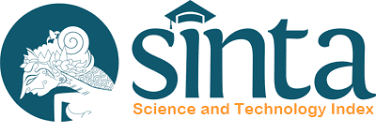Optimasi Parameter Support Vector Regression (SVR) Menggunakan Algoritma Grey Wolf Optimizer (GWO)
DOI:
https://doi.org/10.26555/jim.v11i2.30889Keywords:
Prediksi ,, Corelation Based Feature Selection (CFS) ,, Grid Search Optimization (GSO),, Support Vector Regression (SVR) ,Abstract
Prediksi adalah suatu metode yang dilakukan untuk mendapatkan gambaran atau memperkirakan sesuatu yang terjadi di masa yang akan datang dengan menggunakan informasi atau data yang ada pada masa lampau dan masa kini. Support Vector Regression (SVR) merupakan salah satu metode yang digunakan untuk melakukan prediksi. Penelitian ini dilakukan dengan tujuan untuk meningkatkan performa dari SVR dalam memprediksi harga saham pada periode 1 februari 2021 hingga 23 februari 2023. Oleh karena itu pada penelitian ini menggunakan seleksi fitur Corelation Based Feature Selection (CFS) dan metode optimasi Grid Search Optimization (GSO) yang diimplementasikan pada SVR. Hasil penelitian menunjukkan bahwa prediksi model SVR diperoleh nilai RMSE sebesar 0.00703 pada data training dan 0.00611 pada data testing. Sedangkan pada model SVR dengan algoritma GSO diperoleh nilai RMSE sebesar 0.00429 pada data training dan 0.00367 pada data testing. Berdasarkan nilai RMSE yang diperoleh menunjukkan adanya peningkatan performa pada SVR dengan penurunan nilai RMSE sebesar 0.00274 pada data training dan 0.00244 pada data testing.
ABSTRACT
Prediction is a method used to get a picture of or estimate something that will happen in the future using information or data that exists in the past and present. Support Vector Regression (SVR) is one of the methods used to make predictions. This research was conducted with the aim of improving the performance of SVR in predicting stock prices for the period February 1, 2021, to February 23, 2023. Therefore, this study uses the correlation-based feature selection (CFS) and grid search optimization (GSO) optimization methods implemented in SVR. The results showed that the prediction of the SVR model obtained an RMSE value of 0.00703 on training data and 0.00611 on testing data. While the SVR model with the GSO algorithm obtained an RMSE value of 0.00429 in the testing data and 0.00367 in the testing data, based on the RMSE value obtained, it shows an increase in performance in SVR with a decrease in the RMSE value of 0.00274 in the training data and 0.00244 in the testing data.
This is an open-access article under the CC–BY-SA license.
References
Y. Kusumawati, K. Widyatmoko, and C. Irawan, “Gold Price Prediction Using Support Vector
Regression,” J. Appl. Intell. Syst., vol. 7, no. 1, pp. 89–102, 2022, doi: 10.33633/jais.v7i1.6124.
F. C. İskenderoğlu, M. K. Baltacioglu, M. H. Demir, G. Bidini, A. Baldinelli, and L. Barelli,
“Comparison of support vector regression and random forest algorithms for estimating the SOFC
output voltage by considering hydrogen flow rates,” Int. J. Hydrog. Energy, vol. 45, no. 60, pp.
35023–35038, 2020, doi: 10.1016/j.ijhydene.2020.07.265.
Y. S. Amirkhalili, A. Aghsami, and F. Jolai, “Comparison of Time Series ARIMA Model and Support
Vector Regression,” Int. J. Hybrid Inf. Technol., vol. 13, no. 1, pp. 7–18, 2020, doi:
10.21742/ijhit.2020.13.1.02.
C. Peng, Z. Che, T. W. Liao, and Z. Zhang, “Prediction using multi-objective slime mould algorithm
optimized support vector regression model,” Appl. Soft Comput., vol. 145, p. 110580, 2023, doi:
10.1016/j.asoc.2023.110580.
Sukamto, Hadiyanto, and Kurnianingsih, “KNN Optimization Using Grid Search Algorithm for
Preeclampsia Imbalance Class,” E3S Web Conf., vol. 448, 2023, doi: 10.1051/e3sconf/202344802057.
S. Shinde, “Liver Disease Prediction Based on Grid Search and Random Forest Classification,” Int.
J. Eng. Appl. Sci. Technol., vol. 7, no. 1, pp. 136–140, 2022, doi: 10.33564/ijeast.2022.v07i01.020.
T. T. Ngoc, L. Van Dai, and L. B. Minh, “Effects of Data Standardization on Hyperparameter
Optimization with the Grid Search Algorithm Based on Deep Learning: A Case Study of Electric
Load Forecasting,” Adv. Technol. Innov., vol. 7, no. 4, pp. 258–269, 2022, doi:
10.46604/aiti.2022.9227.
Y. Qi, H. Liu, and J. Zhao, “Prediction model and demonstration of regional agricultural carbon
emissions based on Isomap–ACO–ET: a case study of Guangdong Province, China,” Sci. Rep., vol.
13, no. 1, pp. 1–11, 2023, doi: 10.1038/s41598-023-39996-5.
Y. Sun, S. Ding, and Z. Z. & W. Jia, “An improved grid search algorithm to optimize SVR for
prediction,” vol. 25, pp. 5633–5644, 2021.
A. N. Puteri, A. Arizal, and A. D. Achmad, “Feature Selection Correlation-Based pada Prediksi
Nasabah Bank Telemarketing untuk Deposito,” MATRIK J. Manajemen, Tek. Inform. dan Rekayasa
Komput., vol. 20, no. 2, pp. 335–342, 2021, doi: 10.30812/matrik.v20i2.1183.
H. Fröhlich, O. Chapelle, and B. Schölkopf, “Feature Selection for Support Vector Machines using
Genetic Algorithms,” Int. J. AI Tools Spec. Issue Sel. Pap. from 15th IEEE Int. Conf. Tools with AI
2003, vol. 13, no. 4, pp. 791–800, 2004, doi: 10.1142/S0218213004001818.
A. M. Kuruvilla and N. . Balaji, “Heart disease prediction system using Correlation Based Feature
Selection with Multilayer Perceptron approach.,” IOP Conf. Ser. Mater. Sci. Eng., vol. 1085, no. 1,
p. 012028, 2021, doi: 10.1088/1757-899x/1085/1/012028.
Downloads
Published
Issue
Section
License
Copyright (c) 2025 Nia Andriani Laila

This work is licensed under a Creative Commons Attribution-NonCommercial-ShareAlike 4.0 International License.
Authors who publish with this journal agree to the following terms:
1. Authors retain copyright and grant the journal right of first publication with the work simultaneously licensed under a Creative Commons Attribution License that allows others to share the work with an acknowledgment of the work's authorship and initial publication in this journal.
2. Authors are able to enter into separate, additional contractual arrangements for the non-exclusive distribution of the journal's published version of the work (e.g., post it to an institutional repository or publish it in a book), with an acknowledgment of its initial publication in this journal.
3. Authors are permitted and encouraged to post their work online (e.g., in institutional repositories or on their website) prior to and during the submission process, as it can lead to productive exchanges, as well as earlier and greater citation of published work.

This work is licensed under a Creative Commons Attribution-ShareAlike 2.0 Generic License.









